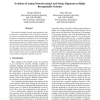Free Online Productivity Tools
i2Speak
i2Symbol
i2OCR
iTex2Img
iWeb2Print
iWeb2Shot
i2Type
iPdf2Split
iPdf2Merge
i2Bopomofo
i2Arabic
i2Style
i2Image
i2PDF
iLatex2Rtf
Sci2ools
Publication
Evolution of Analog Networks using Local String Alignment on Highly Reorganizable Genomes
We introduce and apply a genetic representation for analog electronic circuits based on the association of character strings extracted from the genome with the terminals and parameters of components, and the use of local string alignment to generate the connection between components. The representation produces a variable genome length structure that tolerates the execution of major genome reorganization operators such as duplication and transposition, along with less disruptive ones such as character insertion, deletion and substitution. The representation can be applied also to other analog networks such as artificial neural networks, control systems, and genetic regulatory networks.
Analog Electronic Circuits | EH 2004 | Genome Reorganization Operators | Hardware | Variable Genome Length |
| Added | 20 Aug 2010 |
| Updated | 08 Feb 2012 |
| Type | Conference |
| Year | 2004 |
| Where | 2004 NASA/DoD Conference on Evolution Hardware (EH’04) |
| Authors | Claudio Mattiussi, Dario Floreano |
Comments (0)




